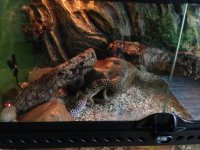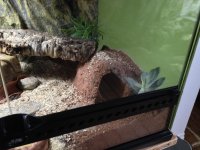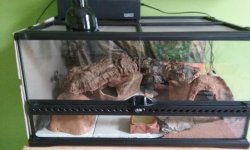I am hoping to find out what went wrong and how to never, ever repeat it should I adopt (ideally) or purchase another Leopard Gecko at a reptile show in the future. I really don't want another Gecko because I want back the one I just lost. I am totally devastated and am having a really hard time with his death that clearly, was inflicted by me. I thought I was doing the utmost in providing the best husbandry, food, vet care etc. I read multiple books, researched studies on everything from Vitamin A, enrichment, UVB, etc., followed Elizabeth's care sheet as well as both excellent commentators like Cricket4U, and Shanes' (maybe same person who also leaves comments on Youtube I think?) comments religiously, but I evidently still messed up.
I was a first time reptile owner as of 11/12/17 when I purchased my gecko from a breeder at the local reptile show in Cincinnati. He was a healthy, with a fat tail, 1.5 year old, 60gram, 9" long male wild/natural morph Leopard Gecko.
I set-up his enclosure 3 weeks in advance of getting him and tested the equipment.
He died at 3:17am January 2nd, 2018 after having spent New Years day at an ER Vet clinic due to a prolapsed cloaca - his 2nd that week, the first from an enema administered by my regular reptile Vet due to a sphagnum moss impaction. At the ER, his cloaca had been reabsorbed from the bath I gave him with a sugar mix, but one of his hemipene was prolapsed as well and remained that way the night he died. He was to have had ER surgery by my Vet yesterday, 1/2/18.
It will take alot for me to explain it in this format, but if you're interested in the chain of events and are interested in helping me, I can disclose all of either this way or the regular forum or phone.
I will list my equipment, feeders, temps here. I was trying to achieve a natural set up with lots of climbing and many passage options for enrichment. Originally had succulent plants with UVB set-up, but removed those items by week 3.
Exo Terra(ET) Medium-Low enclosure, 24 x 18 x 12, plan was to upgrade to 36 x 18 x 18
Excavator clay on cool side with clay tunnel as cool hide; in room with good natural light
2" Sani-Chips on warm side with a few handfuls of Eco-Earth mixed in, both totally digestible; breeder had used sani chips also
scattered large stones and rocks, cleaned and sanitized, mostly on warm side
cork bark,
3 hides: 1 warm hide; 1 most hide with sphagnum moss (1/2 off on warm side; 1/2 on cooler but not cold side); 1 cool side. Thought the moss would help with overall humidity in enclosure and couldn't use eco earth since hide is too shallow and thought he would eat paper towel
1 ET thermometer/hygrometer suctioned 4" from enclosure base on warm side
1 digital thermometer only on cold side suctioned 4" high from ground
1 ZM nano dome light w/ 45W CHE; added to set-up 11/18/17 due to not reaching 82-85 degree ambient temps
1 ET Compact light fixture on dimmer with 30W regular LED house bulb dimmed to less than 1/2 strength, on timer to simulate morning light and early evening sundown; 6:35am - 10am and 4:30pm - 6:35pm)
ZooMed UTH, 12 x 8 attached to Jumpstart thermostat set to 90-91 degrees attached to center of warm hide with probe on top of substrate
Temps: Ambient per ET therm/hygrometr on WARM side: varied often from 76.6 - 83, rarely over 80
Ground: 85 - 92, warm side; 71 - 75, cool side
Warm side under hide: 87 - 89 typically until last 2 weeks where they were 87 - 94
Ambient Cold Air side: 71- 76
Cold Hide: 71 - 75
Humidity (as read by ET therm/hygrom on warm side): low 20's- to 45, but had to mist CONSTANTLY.
When measured with heat gun, there was always a big difference b/t the warm side thermostat measurements and the gun measurements under the warm hide and around it on the ground. The Jumpstart would say 93, but under the hide it would read 89. I was CONSTANTLY taking readings through out the day(currently unemployed). I consulted with alot of experienced folks who all stated my temps were good, but I always felt they were too low on the warm end, both ambient and under warm hide, but he was a great eater and his stool was always healthy etc.
Food: (The breeder fed my gecko daily with a combo of various worms and dubious, never any crickets); starting 11/12, my gecko was fed: M (dubias with Reptivite D3), Th (dubias with Herptavite V/M); Sat (giant mealworms, no dusting). I did not dust with V/M every Thurs. but every 4th feed instead. Giant mealworms gut loaded with carrot; Dubias constant supply of fresh kale, orange slices. He only received Calcium w/D3.
When he stopped eating on 12/21, I put a small cap of phosphorous-free, PLAIN calcium NO D3 in water bottle cap in cage because I was worried about him not getting calcium from not eating. Otherwise, there was never a calcium dish in his cage. He was tong-fed every time, except with mealworms where I placed one at time in a dish as I watched him eat them; was fed as much as he could eat in 10-15 min.
I know this is a really long post. Thank you for your time.
I was a first time reptile owner as of 11/12/17 when I purchased my gecko from a breeder at the local reptile show in Cincinnati. He was a healthy, with a fat tail, 1.5 year old, 60gram, 9" long male wild/natural morph Leopard Gecko.
I set-up his enclosure 3 weeks in advance of getting him and tested the equipment.
He died at 3:17am January 2nd, 2018 after having spent New Years day at an ER Vet clinic due to a prolapsed cloaca - his 2nd that week, the first from an enema administered by my regular reptile Vet due to a sphagnum moss impaction. At the ER, his cloaca had been reabsorbed from the bath I gave him with a sugar mix, but one of his hemipene was prolapsed as well and remained that way the night he died. He was to have had ER surgery by my Vet yesterday, 1/2/18.
It will take alot for me to explain it in this format, but if you're interested in the chain of events and are interested in helping me, I can disclose all of either this way or the regular forum or phone.
I will list my equipment, feeders, temps here. I was trying to achieve a natural set up with lots of climbing and many passage options for enrichment. Originally had succulent plants with UVB set-up, but removed those items by week 3.
Exo Terra(ET) Medium-Low enclosure, 24 x 18 x 12, plan was to upgrade to 36 x 18 x 18
Excavator clay on cool side with clay tunnel as cool hide; in room with good natural light
2" Sani-Chips on warm side with a few handfuls of Eco-Earth mixed in, both totally digestible; breeder had used sani chips also
scattered large stones and rocks, cleaned and sanitized, mostly on warm side
cork bark,
3 hides: 1 warm hide; 1 most hide with sphagnum moss (1/2 off on warm side; 1/2 on cooler but not cold side); 1 cool side. Thought the moss would help with overall humidity in enclosure and couldn't use eco earth since hide is too shallow and thought he would eat paper towel
1 ET thermometer/hygrometer suctioned 4" from enclosure base on warm side
1 digital thermometer only on cold side suctioned 4" high from ground
1 ZM nano dome light w/ 45W CHE; added to set-up 11/18/17 due to not reaching 82-85 degree ambient temps
1 ET Compact light fixture on dimmer with 30W regular LED house bulb dimmed to less than 1/2 strength, on timer to simulate morning light and early evening sundown; 6:35am - 10am and 4:30pm - 6:35pm)
ZooMed UTH, 12 x 8 attached to Jumpstart thermostat set to 90-91 degrees attached to center of warm hide with probe on top of substrate
Temps: Ambient per ET therm/hygrometr on WARM side: varied often from 76.6 - 83, rarely over 80
Ground: 85 - 92, warm side; 71 - 75, cool side
Warm side under hide: 87 - 89 typically until last 2 weeks where they were 87 - 94
Ambient Cold Air side: 71- 76
Cold Hide: 71 - 75
Humidity (as read by ET therm/hygrom on warm side): low 20's- to 45, but had to mist CONSTANTLY.
When measured with heat gun, there was always a big difference b/t the warm side thermostat measurements and the gun measurements under the warm hide and around it on the ground. The Jumpstart would say 93, but under the hide it would read 89. I was CONSTANTLY taking readings through out the day(currently unemployed). I consulted with alot of experienced folks who all stated my temps were good, but I always felt they were too low on the warm end, both ambient and under warm hide, but he was a great eater and his stool was always healthy etc.
Food: (The breeder fed my gecko daily with a combo of various worms and dubious, never any crickets); starting 11/12, my gecko was fed: M (dubias with Reptivite D3), Th (dubias with Herptavite V/M); Sat (giant mealworms, no dusting). I did not dust with V/M every Thurs. but every 4th feed instead. Giant mealworms gut loaded with carrot; Dubias constant supply of fresh kale, orange slices. He only received Calcium w/D3.
When he stopped eating on 12/21, I put a small cap of phosphorous-free, PLAIN calcium NO D3 in water bottle cap in cage because I was worried about him not getting calcium from not eating. Otherwise, there was never a calcium dish in his cage. He was tong-fed every time, except with mealworms where I placed one at time in a dish as I watched him eat them; was fed as much as he could eat in 10-15 min.
I know this is a really long post. Thank you for your time.
Last edited:






